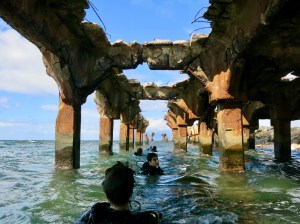Maui Dive Sites: Shore vs Boat Diving

How to Scuba Dive in Maui
Maui dive sites give scuba divers the option of excellent shore and boat diving! Shore diving is easy. You put on your scuba diving equipment and enter the ocean from a local beach. In Lahaina, there is no need to wake up early for a boat charter to discover the best of Maui underwater.
Even as a seasoned PADI scuba instructor, my first shore dive was in Maui. I had worked for many years on different scuba diving boats, so I didn’t even consider the idea of not boat diving! I thought the best underwater life must be found far out at sea. But, wow, I was wrong! Scuba diving from the beach can be  excellent. Plus, shore diving is suitable for certified and beginner divers, so anyone over 10 years old can scuba dive in Maui at dive sites like Airport Beach in Kaanapali and Mala Wharf in Lahaina.
excellent. Plus, shore diving is suitable for certified and beginner divers, so anyone over 10 years old can scuba dive in Maui at dive sites like Airport Beach in Kaanapali and Mala Wharf in Lahaina.
The island blessed my first Maui scuba dive. On a calm day, I easily entered the ocean in Kaanapali from the beach. I put on my dive mask and fins and then descended underwater. Within 10 minutes of combing over a good stretch of the colorful Hawaiian coral reef, a huge Reef Manta Ray appeared in about 20 feet of water. The significant visitor had a wingspan of at least 10 feet! I hovered over the coral reef, mesmerized by the grace and movements of the Reef Manta Ray. Then I spent an incredible 20 MINUTES swimming alongside her. She slowly cruised over the coral reef and continuously examined my alien presence. This scuba dive immediately erased any potential doubts I had about Maui shore diving. Amazingly, it was the first dive my future husband and I had ever done together. It felt like Maui had opened her arms and Banyan Tree Divers Maui was born.
But how does scuba diving from the beach compare with boat diving? Our answer always centers around the specific needs of each diver. For example, when someone needs to experience being on a boat and diving deeper than 80 feet, boat diving checks all the boxes! We would refer certified divers to the local dive shops with a boat in Lahaina.
Shore diving wins most of the time because scuba divers get a flexible start time, convenient locations, and easy access to Hawaii’s colorful marine life. You scuba dive with more Hawaiin Green Turtles shore diving in Lahaina than boat diving anywhere in Maui! Plus, even introductory divers can experience Maui’s number one scuba location, the excellent Mala Wharf in Lahaina. Mala Pier has a maximum depth of 30 feet and never disappoints!
Maui Dive Sites from Shore and Boat
Maui dive sites feature vast stretches of fringing coral reef stretching along the south and west-facing coastlines. When scuba divers get calm ocean conditions, you can see intricate coral formations right through the surface. Almost 50 percent of the coral species in Hawaii are considered coral reef builders, in contrast to the soft corals found in more ancient reef systems. Over 20 percent of the 90-plus Hawaiian coral species are endemic. Extensive Pacific Ocean exposure to El Nino storms has limited the development of coral reef varieties. Indeed just four robust coral species dominate 75 percent of the reef biodiversity throughout the Hawaiian islands.
The Hawaiian Islands have always been one of the world’s most isolated marine ecosystems globally, so Hawaii has 25 percent endemic fish species. Scuba diving in Maui, you explore underwater near fish not found anywhere else on Earth!
Shore Diving in Maui
You can stay close to your hotel in Kaanapali to scuba dive. Most dive spots require a short walk in your scuba equipment, minimal surface swimming, and begin in less than 10 feet of water. An array of fish greets you during your first few breaths, including Longfin Bannerfish, Triggerfish (the  official state fish of Hawaii), Pufferfish, colorful Parrotfish, and many varieties of Wrasse.
official state fish of Hawaii), Pufferfish, colorful Parrotfish, and many varieties of Wrasse.
Turtles make frequent companions during most Maui scuba dives! Plus, every dive site features an abundance of moray eels. You can visit Mala Wharf in Lahaina, where it is almost guaranteed to see White Tip Reef Sharks.
If you travel with family members who are not scuba divers, you can still go shore diving without leaving your family for the entire day. Shore diving in Lahaina provides the convenience of scuba diving near your Maui hotel. You don’t have to dedicate your day to a boat diving excursion. Instead, you can complete two shore dives before lunchtime. Also no boat, no seasickness!
Maui’s coral reefs remain my biggest concern about scuba diving near countless hotels and cruise ships. Sadly, worldwide the majority of coral reefs sit in peril. While Hawaiian coral reefs are not exempt, these reefs have not seen devastation like the Great Barrier Reef in Australia. The nearshore ocean cannot take the stress of modern-day life. Agricultural Runoff, rising ocean temperatures, land development, overfishing, massive tourism, and even sunscreen contribute to coral reefs’ degradation. You can see this destruction throughout the Hawaiian islands scuba diving from shore or a boat.
When you encounter any swath of compromised coral reefs, use the opportunity to generate underwater awareness. It is essential to link how human behavior affects this delicate system that provides comprehensive coastal protection and millions of dollars in yearly revenue. Sometimes one must experience an issue firsthand to care about it, pay for it, and hopefully do something about it. Coral reefs worldwide remain healthier in undeveloped areas, of which few remain.
Boat Diving in Maui
You can access most Maui dive locations from shore, but everything else requires a boat. Maui’s two famous boat diving spots are the crescent-shaped Molokini Crater (between Maui and Kahoolawe) and Lanai’s Cathedrals. The island of Lana’i sits closest to Maui divided by a fairly calm channel. Advanced certified scuba divers can also visit Molokai to experience some of the best Hammerhead Shark diving in the world. Go Hammerhead Shark diving in June for the chance to see 100-plus sharks!
Scuba diving by boat near the island of Lanai provides impressive rock formations, where you can experience kicking your fins through small caverns and lava tubes. It is exhilarating to be out on the open Pacific Ocean and descend into an abyss of geological formations. The excitement of exploring depths of up to 130 feet can make that dawn check-in worth it! Moray Eels, various nudibranchs, frogfish, spiny lobsters, and the occasional White Tip Reef Shark bring a delicate balance of sea life to the impressive underwater topography.
Molokini Crater could be Hawaii’s most frequently visited snorkel and scuba diving site. Boat charters with novice swimmers and snorkelers dominate the coral reef system inside the crater. Luckily scuba divers can escape the crowd! When the current inside the crater is not pumping, your instructor can lead you to explore the outer edges of the crater rim. The deeper depths in this area thrive with schools of triggerfish, parrotfish, and damselfish.
On calm days at Molokini Crater, scuba divers with advanced certifications can dive the backside wall. Molokini’s back wall makes an ideal playground for experienced scuba divers! The back wall drops to about 200 feet. This dive site looks similar to scuba diving in Dahab, Egypt.
Maui scuba divers craving a wreck dive can visit the Carthaginian in Lahaina. Resting at about 100 feet, the intentionally sunk Carthaginian was laid to rest in 2005. Since then, it has amassed new coral colonies that attract big schools of fish, Nudibranchs, and White Tip Reef Sharks. You might even see a passing Humpback Whale here in January or February!
The Hawaiian islands face exposure to extreme weather conditions. All islands in the chain are profoundly affected by trade winds and swell. When you go boat diving, remember Maui’s ocean can be rough. All scuba divers prone to seasickness must consider preventative measures before getting on the boat.
Your Best Maui Scuba Experience
If you want the best Maui scuba diving experience but still can’t decide between shore and boat diving, go for both options! One day you can beach dive around Lahaina, and the next you can descend a mooring line near Lanai. Scuba divers encounter a great variety and abundance of sea life at every Maui dive site.
But no matter where you scuba dive in Maui, please respectfully experience Hawaii’s marine life. You can take beginner diving lessons or begin a PADI course, but leave Maui’s ocean as untouched as you found it!
Corals break easily! Do your part to protect the corals for future generations by keeping a good distance from the coral reef with your fins, boots, feet, gloves, and hands. Scuba divers and snorkelers should never touch the coral reef.
We hope you enjoyed our blog post! You can stay connected with Banyan Tree Divers Maui by checking our newest reviews on TripAdvisor or Google and reading our latest blog.
